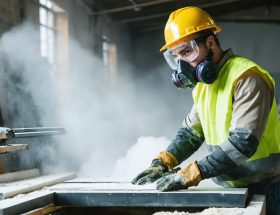In today’s high-stakes business environment, effective risk management isn’t just a compliance requirement—it’s a crucial operational advantage. Managing stone processing health risks and other workplace hazards demands a systematic, proactive approach that protects both assets and employees.
The six-step risk management process transforms complex workplace challenges into manageable, actionable protocols. When properly implemented, this framework helps organizations identify potential threats before they materialize, allocate resources efficiently, and maintain operational continuity even under challenging conditions. For facility managers and safety officers, mastering these steps isn’t just about compliance—it’s about creating a resilient workplace that can adapt to emerging risks while maintaining productivity.
Understanding and implementing a structured risk management approach is particularly critical in industries where physical hazards, environmental concerns, and regulatory requirements intersect. By following a proven methodology, organizations can move beyond reactive safety measures to develop comprehensive risk mitigation strategies that protect their workforce, maintain operational efficiency, and ensure long-term sustainability.
Step 1: Hazard Identification in Stone Processing

Physical Hazards
Physical hazards in stone processing facilities require careful attention and management to ensure worker safety. Dust generated during cutting and grinding operations poses significant respiratory risks and can reduce visibility in work areas. Implementing proper dust collection systems and following OSHA safety standards is crucial for maintaining air quality.
Noise from cutting equipment and machinery frequently exceeds safe decibel levels, potentially causing permanent hearing damage. Workers must use appropriate hearing protection and undergo regular audiometric testing. Vibration from handheld tools and heavy machinery can lead to hand-arm vibration syndrome (HAVS) or whole-body vibration issues when not properly controlled.
Flying particles during cutting, grinding, and polishing operations present serious eye and face injury risks. Proper guards on machinery, along with personal protective equipment like safety glasses and face shields, are essential. Regular equipment maintenance, worker training, and clearly marked safety zones help minimize these physical hazards while maintaining productive operations.
Chemical Hazards
Chemical hazards represent a significant concern in stone processing facilities, with silica exposure risks being the primary threat. When cutting, grinding, or polishing natural stone, crystalline silica dust becomes airborne, potentially causing serious respiratory issues if proper controls aren’t in place. Other chemical hazards include exposure to sealants, adhesives, and cleaning products commonly used in stone fabrication.
To effectively manage these risks, facilities should implement a comprehensive monitoring system that includes regular air quality testing and exposure assessments. Essential control measures include proper ventilation systems, dust collection equipment, and wet-cutting methods to minimize airborne particles. Personal protective equipment (PPE) such as respirators, protective eyewear, and appropriate gloves must be provided and properly maintained.
Regular training sessions should educate workers about chemical hazard recognition, proper handling procedures, and emergency response protocols. Documentation of all chemical substances present in the workplace, including detailed safety data sheets (SDS), must be readily accessible to all employees.
Step 2: Risk Assessment and Analysis
Once hazards are identified, the next crucial phase involves systematically evaluating each risk to determine its potential impact and likelihood of occurrence. This assessment uses both qualitative and quantitative methods to prioritize risks effectively.
Start by rating each identified risk on two key dimensions: severity and probability. Severity measures the potential consequences if the risk materializes, ranging from minor inconveniences to catastrophic outcomes affecting life, property, or business operations. Probability assesses how likely the risk is to occur, from rare events to near-certain occurrences.
Use a risk matrix to plot these ratings, typically on a 5×5 grid, where severity and probability intersect to provide a clear risk level indication. This visual tool helps categorize risks as low, medium, or high priority, enabling better resource allocation for risk mitigation.
Consider both direct and indirect impacts:
– Financial losses
– Worker safety implications
– Equipment damage
– Production downtime
– Regulatory compliance issues
– Reputation damage
Document your findings in a risk register, including:
– Detailed risk descriptions
– Current control measures
– Risk ratings
– Assessment methodology
– Assessment date
– Responsible personnel
Regular review of these assessments is essential, as risk factors can change with new equipment, processes, or regulations. Involve workers and supervisors in the assessment process, as they often provide valuable insights from practical experience.
This systematic approach ensures that risk management efforts focus on the most critical areas first, maximizing the effectiveness of your safety program while optimizing resource allocation.

Step 3: Control Measure Development
Engineering Controls
Engineering controls serve as crucial physical barriers between workers and hazards in stone processing facilities. Properly designed ventilation systems are essential for removing harmful dust particles and maintaining air quality. Local exhaust ventilation (LEV) systems should be strategically placed near cutting and grinding stations to capture dust at its source before it spreads throughout the facility.
Dust collection systems, including high-efficiency particulate air (HEPA) filters, effectively trap fine particles generated during stone fabrication. These systems should be regularly maintained and monitored to ensure optimal performance. Water-integrated cutting and grinding equipment helps suppress dust generation while processing stone materials.
Equipment modifications can significantly reduce exposure to hazards. Installing machine guards, emergency stop buttons, and automatic shut-off mechanisms provides additional layers of protection. Enclosed booths for specific processes and sound-dampening materials help control noise levels. Regular assessment and upgrading of these engineering controls ensure they remain effective in minimizing workplace risks and maintaining compliance with safety standards.
Remember that engineering controls should be complemented by proper maintenance schedules and regular effectiveness testing to maintain their protective capabilities.

Administrative Controls
Administrative controls serve as essential workplace practices that reduce exposure to hazards when engineering controls aren’t feasible or sufficient. In stone processing facilities, these controls include implementing proper training programs, establishing clear safety protocols, and developing effective work schedules.
Worker training should cover proper equipment operation, hazard recognition, and emergency response procedures. Regular safety meetings keep risk awareness high and provide opportunities to address emerging concerns. Job rotation schedules help minimize prolonged exposure to specific hazards, while break schedules ensure workers maintain alertness during critical tasks.
Standard Operating Procedures (SOPs) should detail step-by-step instructions for routine operations, maintenance tasks, and emergency situations. These procedures must be regularly reviewed and updated to reflect current best practices and equipment modifications.
Documentation and recordkeeping play vital roles in administrative controls. Maintain detailed logs of training sessions, equipment inspections, and incident reports. This documentation not only ensures compliance but also helps identify patterns and areas requiring additional attention.
Consider implementing a buddy system for high-risk tasks and establishing clear communication protocols between different work areas to enhance overall workplace safety.
Step 4: Implementation of Safety Measures
Once control measures have been identified and approved, implementing them effectively requires careful planning and systematic execution. Begin by developing a detailed implementation schedule that outlines specific timelines, responsibilities, and resource requirements for each safety measure.
Start with quick wins – those measures that can be implemented immediately with minimal resource investment. This might include posting safety signage, reorganizing workspaces, or updating standard operating procedures. For more complex controls, such as installing new ventilation systems or implementing engineering solutions, create a phased approach to ensure minimal disruption to operations.
Training is crucial during this phase. Ensure all employees receive comprehensive instruction on new procedures, equipment, or safety protocols. Document all training sessions and maintain records of employee participation. Consider creating visual aids, checklists, and reference materials to support consistent implementation.
Communication plays a vital role in successful implementation. Regularly update stakeholders on progress, challenges, and any adjustments to the implementation plan. Establish clear channels for feedback and encourage workers to report any issues or suggestions for improvement.
Monitor the implementation process closely to ensure measures are being adopted correctly. Conduct regular inspections and audits to verify compliance and effectiveness. Pay special attention to areas where resistance to change might occur and address concerns promptly.
Remember that implementation is not a one-time event but an ongoing process. Be prepared to make adjustments based on real-world feedback and changing conditions. Maintain detailed documentation of all implementation activities, including dates, responsible parties, and any modifications made to the original plan.
Step 5: Monitoring and Review
Monitoring and reviewing your risk management controls is not a one-time task but an ongoing process that ensures your safety measures remain effective over time. Regular monitoring helps identify any gaps in your control measures and allows for timely adjustments when needed.
Begin by establishing clear performance indicators for each control measure. These might include incident rates, near-miss reports, or compliance metrics. Document all monitoring activities and maintain detailed records of safety inspections, maintenance checks, and employee feedback.
Conduct periodic assessments of your control measures through:
– Weekly workplace inspections
– Monthly review of incident reports
– Quarterly analysis of safety data
– Annual comprehensive risk assessment updates
Pay special attention to changes in your operation that might affect existing controls, such as new equipment installations, process modifications, or staff turnover. When issues are identified, take immediate corrective action and document the improvements made.
Encourage active participation from your workforce in the monitoring process. Workers often notice day-to-day changes that might impact safety before they appear in formal reports. Create clear communication channels for reporting concerns and suggestions.
Remember that evolving industry standards and new technologies may offer better solutions for managing risks. Stay informed about industry best practices and be prepared to update your control measures accordingly. This proactive approach helps ensure your risk management strategy remains robust and effective.
Step 6: Documentation and Communication
Thorough documentation and clear communication are crucial components of an effective risk management process in stone processing facilities. Maintaining detailed records of safety protocols and documentation ensures compliance with regulations and provides valuable historical data for future risk assessments.
Essential documentation should include:
– Risk assessment reports and findings
– Implemented control measures and their effectiveness
– Incident reports and investigation outcomes
– Training records and certifications
– Equipment maintenance logs
– Emergency response procedures
Communication strategies should focus on making this information accessible to all stakeholders through:
– Regular safety meetings and briefings
– Digital documentation systems
– Clear signage and visual aids
– Multi-language resources when necessary
– Emergency response chain of command
– Updated contact lists for key personnel
Regular review and updates of documentation ensure that risk management remains current and effective. Establish a standardized system for reporting incidents and near-misses, making it easy for employees to contribute to the safety culture. Consider implementing a digital documentation system that allows for quick access and updates while maintaining secure backups of all critical information.
Remember to distribute relevant safety information across all organizational levels and maintain open channels for feedback and suggestions from workers on the processing floor.
Effective risk management in the stone processing industry is not a one-time endeavor but a continuous cycle of evaluation and improvement. By following these six essential steps – hazard identification, risk assessment, control measures implementation, documentation, monitoring, and regular review – organizations can create a safer, more efficient workplace while protecting their most valuable assets: their employees and operations.
Remember that successful risk management requires commitment from all levels of the organization, from leadership to frontline workers. Regular training, open communication channels, and a culture of safety awareness are crucial elements that support this process. As industry standards evolve and new technologies emerge, your risk management approach should also adapt and grow.
Make it a priority to review and update your risk management procedures at least annually, or whenever significant changes occur in your operations. By maintaining this proactive stance toward safety and risk mitigation, you not only comply with regulatory requirements but also demonstrate your commitment to workplace safety and operational excellence. This investment in risk management will ultimately lead to improved productivity, reduced incidents, and enhanced business sustainability.










